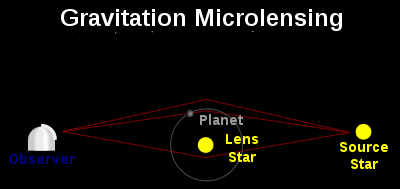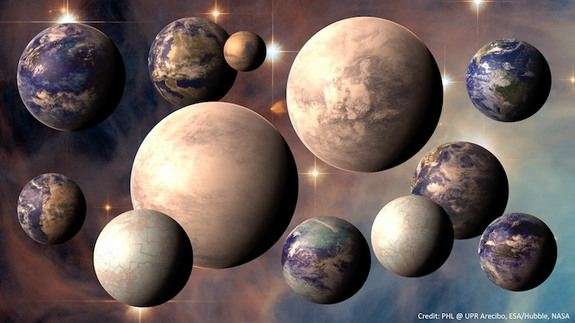It looks like you're using an Ad Blocker.
Please white-list or disable AboveTopSecret.com in your ad-blocking tool.
Thank you.
Some features of ATS will be disabled while you continue to use an ad-blocker.
6
share:
Yet another study that basically says Earth-like exoplanets are very common in our Universe.


Read the whole article here
Previous related ATS threads:
- 22-06-2010: Are We Alone? NASA Spacecraft Finds 706 Possible Earth-Like Planets
- 23-07-2010: More than 100 'Earth-like' planets discovered in past few weeks
- 20-02-2011: There are 500 million planets in OUR OWN GALAXY capable of producing life
- 14-05-2011: 86 planets to be searched for aliens
- 12-01-2012: 160 Billion! The New Estimate of Alien Planets in the Milky Way
- 07-02-2013: Kepler Space Telescope Data Reveals Billions Of Earth-Like Planets Near Earth
Researchers at The University of Auckland have proposed a new method for finding Earth-like planets and they anticipate that the number will be in the order of 100 billion.
The strategy uses a technique called gravitational microlensing, currently used by a Japan-New Zealand collaboration called MOA (Microlensing Observations in Astrophysics) at New Zealand's Mt John Observatory. Their work will appear in the Oxford University Press journal Monthly Notices of the Royal Astronomical Society.

Lead author Dr Phil Yock from the University of Auckland's Department of Physics explains that the work will require a combination of data from microlensing and the NASA Kepler space telescope.
"Kepler finds Earth-sized planets that are quite close to parent stars, and it estimates that there are 17 billion such planets in the Milky Way. These planets are generally hotter than Earth, although some could be of a similar temperature (and therefore habitable) if they're orbiting a cool star called a red dwarf."

"Our proposal is to measure the number of Earth-mass planets orbiting stars at distances typically twice the Sun-Earth distance. Our planets will therefore be cooler than the Earth. By interpolating between the Kepler and MOA results, we should get a good estimate of the number of Earth-like, habitable planets in the Galaxy. We anticipate a number in the order of 100 billion."
"Of course, it will be a long way from measuring this number to actually finding inhabited planets, but it will be a step along the way."
Read the whole article here
Previous related ATS threads:
- 22-06-2010: Are We Alone? NASA Spacecraft Finds 706 Possible Earth-Like Planets
- 23-07-2010: More than 100 'Earth-like' planets discovered in past few weeks
- 20-02-2011: There are 500 million planets in OUR OWN GALAXY capable of producing life
- 14-05-2011: 86 planets to be searched for aliens
- 12-01-2012: 160 Billion! The New Estimate of Alien Planets in the Milky Way
- 07-02-2013: Kepler Space Telescope Data Reveals Billions Of Earth-Like Planets Near Earth
Good find and quite interesting. It will be great to see this process adopted as an astronomical methodology and see what comes out of it. I know
new equipment and methods are under development to achieve this and other goals. Flag for you and my best,
Life is the universe itself, and the universe has slowly evolved the life into intelligent life, thus the universe is becoming self aware. We are the
universe, the universe is us. The universe is all around you, every atom, every partical, all matter and anti matter. If we, our species kill ourself
and take earth with us, it will be a wasted chance. But there are others who will not destroy themselfs, and which will slowly evolve more intelligent
beings. Or, maybe there are already highly evolved beings, who are seeding other planets with the right climate life, so that they may evolve too,
and discover itself.
Given the number of galaxies/solar systems its obvious that a certain number will be close enough to our orbit....if they would support us popping
down and opening the capsule and expecting a lung full of fresh air may be another thing
That's more than one each
I can have my Monkey world
Wow just wow I mean we can't even imagine the size of the number let alone each number is another world !!!!
S&F for blowing my tiny mind
I can have my Monkey world
Wow just wow I mean we can't even imagine the size of the number let alone each number is another world !!!!
S&F for blowing my tiny mind
Awesome read. Just imagine if we would find a planet that has life on it. I just hope we wouldnt go there and destroy it and kill everything, like we
do to our own planet.
There are likely more habitable planets in the galaxy than people on Earth, that's an awesome thought. How many and diverse alien culture?
a reply to: elevenaugust
Not surprising in the least. Us humans are so damn arrogant and narcissistic as to think god created the whole dang universe just for little old us! Thanks or all the room dad!
There universe is probably oozing with life, even possibly at our own back door.
Not surprising in the least. Us humans are so damn arrogant and narcissistic as to think god created the whole dang universe just for little old us! Thanks or all the room dad!
There universe is probably oozing with life, even possibly at our own back door.
edit on 29-9-2014 by Mrs.Peony because: spelling
new topics
-
Trump picks Gov. Kristi Noem to serve as homeland security secretary
2024 Elections: 3 hours ago -
Elon's Starlink Stole The Election For Trump--Leftist Conspiracy Theorists Charge
General Conspiracies: 6 hours ago -
Speaker Johnson Orders Entire Biden Administration to Preserve and Retain All Records - Documents
US Political Madness: 7 hours ago -
Resident Plane enthusiasts needed weird noise
General Chit Chat: 10 hours ago
top topics
-
Fired FEMA Employee Says It Was Not ‘Isolated’ Incident: ‘Colossal Event Of Avoidance’
US Political Madness: 13 hours ago, 25 flags -
Speaker Johnson Orders Entire Biden Administration to Preserve and Retain All Records - Documents
US Political Madness: 7 hours ago, 17 flags -
Elon's Starlink Stole The Election For Trump--Leftist Conspiracy Theorists Charge
General Conspiracies: 6 hours ago, 16 flags -
Trump picks Gov. Kristi Noem to serve as homeland security secretary
2024 Elections: 3 hours ago, 11 flags -
Australia has been holding out on us
Music: 13 hours ago, 4 flags -
Resident Plane enthusiasts needed weird noise
General Chit Chat: 10 hours ago, 4 flags
active topics
-
President-Elect Donald Trump will Meet with Coup-Victim JOE BIDEN on Wed 11.13.2024.
2024 Elections • 19 • : tomeville -
President-Elect DONALD TRUMP's 2nd-Term Administration Takes Shape.
Political Ideology • 133 • : WeMustCare -
Otherworldly wreckage found on Mars…
Space Exploration • 36 • : JJproductions -
Elon's Starlink Stole The Election For Trump--Leftist Conspiracy Theorists Charge
General Conspiracies • 26 • : Dalamax -
Speaker Johnson Orders Entire Biden Administration to Preserve and Retain All Records - Documents
US Political Madness • 22 • : Dalamax -
Diddy Arrested in NYC After Grand Jury Indictment
Other Current Events • 16 • : WeMustCare -
Trump picks Gov. Kristi Noem to serve as homeland security secretary
2024 Elections • 12 • : WeMustCare -
Australia has been holding out on us
Music • 5 • : Dalamax -
Your Opinion ... 2nd assassination attempt ... the shooter was a ... ????
Political Conspiracies • 277 • : Therealbeverage -
Will Biden Step Down
US Political Madness • 48 • : Therealbeverage
6
